What led to the Sri Lankan economic crisis?
Dimple Baruah is currently pursuing her master's degree in International Studies from Christ (Deemed to be University) and is a Political Science graduate from Delhi University. She loves sketching and animals. She is an International Relations and Global Politics enthusiast. Her field of interest lies in the geopolitics of South Asia and the theories of International Relations.
Sri Lanka is in the midst of its worst economic crisis since its 1948 independence. This can be traced back to several fundamental problems that worsened financial situations. Inflation has reached a new high. The tourism industry has been hit severely after the covid-19 pandemic. The country’s debt profile is deteriorating, and a lack of foreign money has made it impossible to purchase imports. The sole cause of this crisis would be ill-timed, ineffective economic measures and a lack of foreign exchange reserves. The economic mismanagement of successive governments created and maintained a twin deficit – a budget shortfall and a current account deficit.
On the 1st of April 2022, the President of Sri Lanka, Gotabaya Rajapaksa declared a national emergency after the protests were being held in front of his residence, raising fears of a crackdown on protests. The military has used emergency powers to arrest and hold suspects without warrants, but the scope of the current authorities remains unclear.
1. EVENTS LEADING TO THE CRISIS
To understand what led to the Sri Lankan economic crisis, we have to analyze the preceding events or factors before the final blow to the economy by the pandemic. This rich and wonderful country became a tragedy for reasons that were not recognized. The explanation became clear quickly: a proud and innovative country had devolved into the private domain of a single-family, the Rajapaksas.
The country’s tourism economy suffered from terrorist suicide bombings during Easter in April 2019. Sri Lanka’s tourist sector accounts for 12.6 percent of the country’s GDP (as of 2019). It is heavily reliant on the travel and tourism sector to manage the economy. Nearly 270 people were killed in Columbo after three churches, and luxury hotels were assaulted. As a result, the amount of foreign currency coming into the country from international tourists has decreased.
In December 2019, the newly elected President made a wrong economic decision by cutting down the VAT rates by half. The rates dropped from 15% to 8%, leading to a decline in the country’s income. Faced with a survival dilemma, the Sri Lankan central bank created more currency notes than was prudent. They increased by 1.2 lakh crore (about 26,000 crore rupees in Indian currency), causing significant inflation.
In May 2021, again, a political decision of the President, i.e., turning Sri Lanka into 100% organic agriculture, led to economic turbulence. The government banned the imports of chemical products and fertilizers. This further resulted in crop failure, high food prices, and a degrading agrarian economy.
As the country’s foreign reserves shrink, Sri Lanka is essentially depreciating its currency, potentially increasing Asia’s greatest inflation surge as the government tries to service its debt and pay for imports.
2. CURRENT SCENARIO OF SRI LANKA
2.1. Economic Situation
The current crisis was deeply affected by the cut down on taxes in 2019. The covid hit the tourism industry of Sri Lanka, credit rating agencies, thus shutting it out of international financial markets. In just two years, foreign exchange reserves have plunged by over 70%. The country had only $2.31 billion in reserves as of February, although it faces debt repayments of $7 billion in 2022. The decision by the Rajapaksa government to ban all chemical fertilizers in 2021, which was later reversed, harmed the country’s farm economy and resulted in a decline in the crucial rice yield.
The debt profile of Sri Lanka goes back to the year 2007; market borrowings account for 47 percent of the debt in Colombo, followed by the Asian Development Bank with 13 percent, China and Japan with 10 percent each, the World Bank with 9 percent, and India with 2 percent of the total debt (10 percent account for others; non-residential treasury bills/bond holdings and state-owned enterprises are excluded from this calculation). Analysts believe the government needs to restructure its debt or seek rescue from the International Monetary Fund.
The public faces 10-12 hours of a power cut, examinations have been called off due to the lack of printing papers, fuel and food prices, and touching skies. Cooking is impossible due to a lack of energy. A thousand bakeries have shuttered their doors. Several power facilities have shut down, resulting in widespread power outages. A month’s supply of gas cylinders used to be around 50,000. It’s now down to 2,000, so you can understand the impact on homes. The island’s diesel deficit has hampered public transportation and goods transit.
2.2. Political Situation
Economic woes fuel widespread resentment of the Rajapaksa family, which controls the government. There is a palpable sense of outrage in its core audience of farmers and nationalists. The lack of proper government policies also adds up to economic chaos. If the situation is not addressed, it may result in a change of power. Former President Maithripala Sirisena’s Freedom Party has asked President Rajapaksa to form an all-party administration to allow the country to get through the crisis. He has threatened to exit the coalition if his request is disregarded.
The declaration of emergency grants security forces the authority to arrest and detain people immediately. This was witnessed after hundreds of protesters gathered in the capital, with many attempting to attack the President’s mansion in protest of the government’s “poor handling of economic policy, which has resulted in a state of chaos in the country.” The military has been deployed in the gas stations to ensure efficient distribution. Tear gas and water cannons were reportedly used to control the protests. Night curfews have been imposed in several locations in Sri Lanka.
3. GLOBAL REACTIONS TO THE CRISIS
India, the closest neighbor of Sri Lanka, also has to face repercussions. Refugees influx into the territories of Tamil Nadu. The number is expected to be around 2000-4000. India also has extended help by giving a $1 billion line of credit to stabilize fuel and food prices. Also, a $400 million credit swap arrangement has been sanctioned. So far, essentials such as medicine and rice have been provided under this arrangement. Lanka has been pressed to refinance its loans by China. If the circumstances warrants, India may provide more humanitarian assistance.
The International Monetary Fund (IMF) has suggested increasing the income taxes and VAT rates to control the affected challenging economy. In the next coming days, the International Monetary Fund will begin talks with Sri Lankan authorities on a prospective loan package, according to IMF spokesman Gerry Rice.
Sri Lanka’s geopolitical location can be witnessed in the power struggle for influence in the Indian Ocean between India and China. The country is situated on the vital sea route which connects the east and the west. Therefore it is essential for China for its “Belt and Road” initiative. The government previously rejected a plan to give China outright ownership of land in the port city of Colombo instead of granting Beijing a 99-year lease on 62 hectares.
4. CONCLUSION
Some experts suggest Sri Lanka’s debt should be restructured and repaid over three years. This will save money and ease the burden on Sri Lankans experiencing shortages of imported items like milk powder, pharmaceuticals, gas, and fuel. Along with the government debt of $4.5 billion, Sri Lanka needs to accumulate $2.4 billion for the state-owned and private companies to meet their debt due in 2022.
In the face of mounting economic troubles, most international economists expect things to worsen in the future, with some even predicting disaster as a matter of time. In the short term, the government may be able to alleviate the current crisis with international aid and loans. Still, the situation necessitates rigorous planning and management for long-term economic stability and the state’s welfare in the long run.







